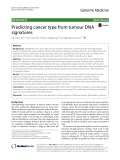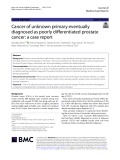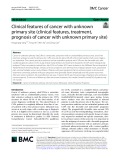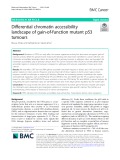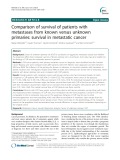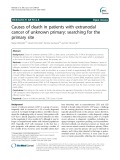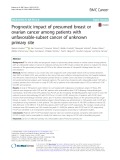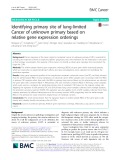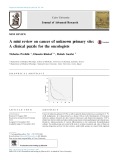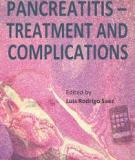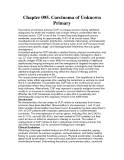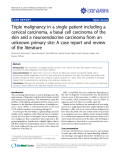
Unknown primary site
-
Establishing the cancer type and site of origin is important in determining the most appropriate course of treatment for cancer patients. Patients with cancer of unknown primary, where the site of origin cannot be established from an examination of the metastatic cancer cells, typically have poor survival. Here, we evaluate the potential and limitations of utilising gene alteration data from tumour DNA to identify cancer types.
 11p
11p  vioraclene
vioraclene
 31-03-2024
31-03-2024
 6
6
 2
2
 Download
Download
-
Prostate cancer has been well known to have a high prevalence among middle-aged and older men, with high incidence of metastases to the bone—the main metastatic site. However, prostate cancer among those less than 50 years of age is extremely rare, and neck swelling is seldom the initial symptom.
 6p
6p  vitiki
vitiki
 30-01-2024
30-01-2024
 3
3
 2
2
 Download
Download
-
Cancer of unknown primary site(CUPs) is a metastatic syndrome with an unidentifable primary tumor, even after extensive workup to seek the primary site. CUPs accounts for about 3%-5% of the total number of all cancer diagnoses worldwide.
 7p
7p  vileonardodavinci
vileonardodavinci
 23-12-2023
23-12-2023
 5
5
 2
2
 Download
Download
-
Mutations in TP53 not only affect its tumour suppressor activity but also exerts oncogenic gain-offunction activity. While the genome-wide mutant p53 binding sites have been identified in cancer cell lines, the chromatin accessibility landscape driven by mutant p53 in primary tumours is unknown.
 15p
15p  vimahuateng
vimahuateng
 26-11-2021
26-11-2021
 11
11
 1
1
 Download
Download
-
Cancer of unknown primary site (CUP) is considered an aggressive metastatic disease but whether the prognosis differs from metastatic cancers of known primary site is not known. Such data may give insight into the biology of CUP and the metastatic process in general.
 8p
8p  vijisoo2711
vijisoo2711
 29-09-2020
29-09-2020
 7
7
 0
0
 Download
Download
-
Cancer of unknown primary (CUP) is a fatal cancer, accounting for 3–5% of all diagnosed cancers. Finding the primary site is important for therapeutic choices and we believe that the organ which is designated as the cause of death may give clues about the primary site.
 8p
8p  virose2711
virose2711
 22-09-2020
22-09-2020
 8
8
 2
2
 Download
Download
-
The clinical utility and prognostic impact of presumed primary breast or ovarian cancer among patients with an unfavorable subset of cancer of unknown primary site (CUP) remains unclear. We aimed to evaluate the clinical relevance of the presumed primary site of CUP and the clinical outcome of site-specific therapy based on such presumptions.
 9p
9p  vibaku2711
vibaku2711
 22-07-2020
22-07-2020
 16
16
 1
1
 Download
Download
-
Precise diagnosis of the tissue origin for metastatic cancer of unknown primary (CUP) is essential for deciding the treatment scheme to improve patients’ prognoses, since the treatment for the metastases is the same as their primary counterparts.
 7p
7p  viputrajaya2711
viputrajaya2711
 22-06-2020
22-06-2020
 8
8
 0
0
 Download
Download
-
Cancer of unknown primary (CUP) is a well recognized clinical syndrome, accounting for 3–5% of all malignancies. It is characterized as a disease with an early dissemination of metastases without a primary detected site after extensive laboratory and clinical investigations. CUP is divided into the favorable and unfavorable groups based on histopathological and clinical manifestations. Adenocarcinoma of various differentiations is the commonest histopathological subtype. Favorable groups are treated with local or systemic treatment and some of them are enjoying long-term survival.
 8p
8p  trinhthamhodang1
trinhthamhodang1
 16-11-2019
16-11-2019
 16
16
 2
2
 Download
Download
-
Long-term survival of outdoor sculpture will be affected by use of the site, adjacent buildings, trees, roads, playgrounds, ponds and similar features. Determine who—pedestrians and pets, cyclists, skateboarders—and how many will use the area and how they will use it. Susan Carr, director of public art, Arts Commission of Greater Toledo, has learned to include users in the mix of design considerations. “Our Major Ritual by Beverly Pepper suffered serious damage from skateboarders. It’s taken a lot of time, dollars and public relations to correct the damage.
 29p
29p  yasuyidol
yasuyidol
 01-04-2013
01-04-2013
 57
57
 4
4
 Download
Download
-
Combined methods have led to further refinements with, for example, high visuospatial resolution afforded by MRI combined with metabolic information from the lesion site (measured with 18F-fluorodeoxyglucose positron emission tomography; FDG-PET) to indicate location and malignancy of gliomas, which in turn informs radiosurgical targeting. Kapsalaki et al. (Chapter 7) consider MRS spectroscopic profiles for differentiation among ring enhancing lesions including high grade gliomas, abscesses and post-radiation necrosis.
 224p
224p  wqwqwqwqwq
wqwqwqwqwq
 21-07-2012
21-07-2012
 95
95
 11
11
 Download
Download
-
Carcinoma of unknown primary (CUP) is a biopsy-proven (mainly epithelial) malignancy for which the anatomic site of origin remains unidentified after an intensive search. CUP is one of the 10 most frequently diagnosed cancers worldwide, accounting for approximately 3–5% of all cancer cases. Most investigators do not consider lymphomas, metastatic melanomas, and metastatic sarcomas that present without a known primary tumor to be CUP because these cancers have specific stage- and histology-based treatments that can guide management. ...
 9p
9p  socolanong
socolanong
 25-04-2012
25-04-2012
 72
72
 3
3
 Download
Download
-
Tuyển tập báo cáo các nghiên cứu khoa học quốc tế ngành y học dành cho các bạn tham khảo đề tài: Triple malignancy in a single patient including a cervical carcinoma, a basal cell carcinoma of the skin and a neuroendocrine carcinoma from an unknown primary site: A case report and review of the literature
 4p
4p  toshiba24
toshiba24
 07-12-2011
07-12-2011
 61
61
 2
2
 Download
Download
-
Harrison's Internal Medicine Chapter 95. Carcinoma of Unknown Primary Carcinoma of Unknown Primary: Introduction Carcinoma of unknown primary (CUP) is a biopsy-proven (mainly epithelial) malignancy for which the anatomic site of origin remains unidentified after an intensive search. CUP is one of the 10 most frequently diagnosed cancers worldwide, accounting for approximately 3–5% of all cancer cases.
 5p
5p  thanhongan
thanhongan
 07-12-2010
07-12-2010
 77
77
 5
5
 Download
Download
-
There are 20 subtypes of cytokeratin (CK) intermediate filaments with different molecular weights and differential expression in various cell types and cancers. Monoclonal antibodies to specific CK subtypes have been used to help classify tumors according to their site of origin; commonly used CK stains in CUP are CK7 and CK20. CK7 is found in tumors of the lung, ovary, endometrium, and breast and not in those of the lower gastrointestinal tract, whereas CK20 is normally expressed in the gastrointestinal epithelium, urothelium, and Merkel's cells.
 5p
5p  thanhongan
thanhongan
 07-12-2010
07-12-2010
 82
82
 3
3
 Download
Download
-
Role of Imaging Studies Chest x-rays are always obtained in CUP workups but are often negative, especially with low-volume disease. CT scans of the chest, abdomen, and pelvis can be used to help find the primary, evaluate the extent of disease, and select the most favorable biopsy site. Older studies suggested that the primary tumor site is detected in 20–35% of patients who undergo a CT scan of the abdomen and pelvis, although by current definition these patients would not be considered as having CUP. ...
 5p
5p  thanhongan
thanhongan
 07-12-2010
07-12-2010
 69
69
 3
3
 Download
Download
-
Nosocomial FUO (See also Chap. 125) The primary considerations in diagnosing nosocomial FUO are the underlying susceptibility of the patient coupled with the potential complications of hospitalization. The original surgical or procedural field is the place to begin a directed physical and laboratory examination for abscesses, hematomas, or infected foreign bodies. More than 50% of patients with nosocomial FUO are infected. Intravascular lines, septic phlebitis, and prostheses are all suspect.
 6p
6p  ongxaemnumber1
ongxaemnumber1
 29-11-2010
29-11-2010
 82
82
 3
3
 Download
Download
CHỦ ĐỀ BẠN MUỐN TÌM








